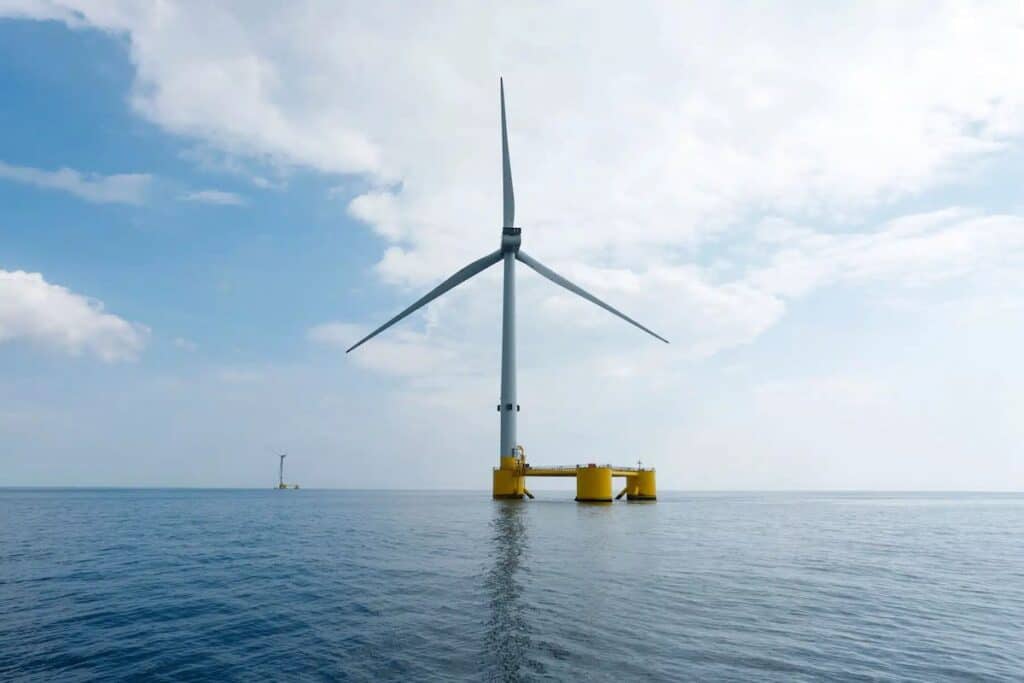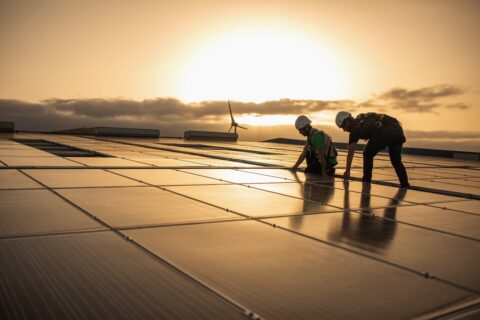
Full planning approval has been granted for what is set to become the world’s biggest floating offshore wind farm, located on a brownfield site in an area of the UK Continental Shelf (UKCS), off the coast of Scotland.
The pioneering Green Volt project is 50% owned by leading offshore wind developer Flotation Energy and 50% owned by Vårgrønn, which is itself a a joint-venture between Plenitude (Eni) and HitecVision.
With offshore approval newly added to onshore consent announced earlier this month, Green Volt has now received all its necessary planning permissions. With an operational target date of 2029, the project remains on track to be the first commercial-scale offshore wind farm in Europe.
Investment in growth sector and supply chain
When completed on a redundant oil and gas field, Green Volt will include up to 35 floating wind turbines, providing up to 560MW of renewable energy capacity to cut carbon emissions by 1M tonnes per annum.
As part of Crown Estate Scotland’s Innovation and Targeted Oil & Gas (INTOG) leasing round, the project will deliver renewable electricity to oil and gas platforms, replacing existing natural gas and diesel power generation. Green Volt will also provide electricity to the UK grid.
Wind energy is an area of focus for economic growth, says First Minister of Scotland Humza Yousaf:
“It is great news that we have consented the first project in Crown Estate Scotland’s INTOG leasing round – this is a significant milestone which will help secure Scotland’s place at the forefront of floating wind technology.
“Scotland is one of the best places in the world to develop offshore wind and its supply chain and we are determined to maximise the huge economic opportunity offshore wind can bring. We have already underlined our commitment to making Scotland a global leader in offshore wind by committing to invest up to £500M over five years to catalyse private investment in the infrastructure and manufacturing facilities critical to the growth of the sector.“
With investor confidence on the rise, there is a pipeline of projects to follow, he adds:
“We have a strong record in delivering robust consents, ensuring the right projects are built in the right place at the right time. Ahead of the Allocation Round 6 (AR6) application window closing, the relevant consents and marine licences were issued for two floating offshore wind projects as well as one wave and three tidal energy projects.”
Green Volt itself will bring jobs and supply-chain benefits, says Nicol Stephen, CEO at Flotation Energy:
“It is fantastic to have received the green light to deliver the world’s biggest floating offshore wind project, right here in the Scottish North Sea. Gaining consent just over a year after our seabed exclusivity was awarded is a testament to the commitment, speed and determination of our Green Volt team, the Scottish Government and its key agencies.
“Green Volt is of international significance, placing Scotland at the leading edge of a new floating wind sector. This multi-billion pound development can now move forward confidently, creating hundreds of local jobs and proving that the UK and Scottish supply chain is ready to deliver commercial scale floating projects, at pace. “
Floating wind will be a huge global market in the decades to come, says Olav Hetland, CEO at Vårgrønn:
“Achieving offshore consent for the project marks an important moment for the whole offshore wind industry. At 560 MW, Green Volt serves as an essential stepping stone from current small-scale projects to gigawatt-size developments, supporting the supply chain in scaling-up new technology.“
Regional ripple effect of innovation at scale
The ripple effect of innovation on this scale is significant at a regional level, too, concludes Sir Ian Wood, Chair of ETZ Ltd, which is spearheading creation of an Energy Transition Zone in the North East of Scotland:
“The awarding of consent for the Green Volt INTOG project is a massive boost for Scotland’s ambition to be a global leader in floating offshore wind. I pay tribute to the Scottish Government and its agencies for taking this welcome decision which follows the opening of the world’s first Floating Wind Innovation Centre in Aberdeen last month.
With one of the largest concentrations of subsea engineering capabilities anywhere in the world and the largest cluster of energy supply chain companies anywhere in the UK, there truly is no better location than the North East of Scotland to invest in low-carbon technologies.”
As part of the North Sea Transition Deal, oil and gas operators have agreed to deliver 50% reduction in offshore greenhouse gas emissions by 2030. In particular, electrification of offshore platforms plays a central role in the new emissions reduction plan published by North Sea Transition Authority in March 2024.
Strategic value of partnership and collaboration
Headquartered in Edinburgh, Scotland, Flotation Energy works to support the big switch to sustainable, clean and affordable energy through the application of innovative offshore wind technology.
An ambitious offshore wind developer, Flotation Energy has a 13GW portfolio that covers both fixed and floating developments globally, with projects in the UK, Ireland, Taiwan, Japan and Australia.
Whilst Flotation Energy develops projects independently, it also recognises the strategic value of partnership and collaboration to deliver proven, cost-effective solutions.
Vårgrønn is an agile, Norway-based offshore wind company. As a joint-venture between the energy company Plenitude (Eni) and the Norwegian energy entrepreneur and investor HitecVision, Vårgrønn is powering the energy transition through development, construction, operation, and ownership of offshore wind assets.
Vårgrønn’s current pipeline of projects and prospective projects spans England, Scotland, Ireland and Norway in addition to early-stage initiatives in the Baltics. The company already holds a 20% share in Dogger Bank A, B and C, the world’s largest wind farm under construction. Its target is to achieve at least 5GW installed and sanctioned offshore wind capacity by 2030 in the Northern European market.
Further Reading:
- More about Green Volt; plus 50-50 joint-venture partners Flotation Energy and Vårgrønn;
- More about the Crown Estate Scotland Innovation and Targeted Oil & Gas (INTOG) leasing round;
- More on the Floating Wind Innovation Centre , recently opened in Aberdeen;
- More on the North Sea Transition Deal; North Sea Transition Authority and its emissions reduction plan;
- More about ETZ Ltd and the Energy Transition Zone plans for NE Scotland;
- Also on SustMeme, Record, but inequitable, growth in renewables;
- Also on SustMeme, Energy transition to add 40 million jobs by 2050;
- Also on SustMeme, World’s first hydrogen double-decker bus unveiled in Aberdeen;
- Also on SustMeme, First hybrid crew transfer vessels for UK offshore wind farm;
- Also on SustMeme, Wind power to headline at Glastonbury Festival;
- Also on SustMeme, Energy transition investment hits $500 billion for first time;
- Also on SustMeme, Rising Tide of Floating Renewables (2017).
Check out the full archive of stories on the SustMeme Climate & Energy Channel, now available to Sponsor.






